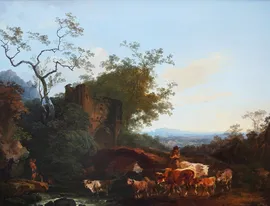Philip James Loutherbourg (1740-1812)
Philip James de Loutherbourg RA (31 October 1740 – 11 March 1812), whose name is sometimes given in the French form of Philippe-Jacques, the German form of Philipp Jakob, or with the English-language epithet of the Younger, was a French-born British painter who became known for his large naval works, his elaborate set designs for London theatres, and his invention of a mechanical theatre called the "Eidophusikon". He also had an interest in faith-healing and the occult, and was a companion of the confidence-trickster Alessandro Cagliostro. Loutherbourg was born in Strasbourg in 1740, the son of an expatriate Polish miniature painter. Intended for the Lutheran ministry, he was educated at the University of Strasbourg. Rejecting a religious calling, Loutherbourg decided to become a painter, and in 1755 placed himself under Charles-André van Loo in Paris, and later under Francesco Giuseppe Casanova. His talent developed rapidly, and he became a figure in the fashionable society of the day. In 1767 he was elected to the French Academy, although below the age required by the rules of the institution, and painted landscapes, sea storms, and battles, all of which work had a celebrity above those of the specialists then working in Paris. He made his debut with the exhibition of twelve pictures, including Storm at Sunset, Night, and Morning after Rain. Loutherbourg then travelled through Switzerland, Germany and Italy, distinguishing himself as much by his mechanical inventions as by his painting. One of these, showing new effects produced in a model theatre, was the wonder of the day, with its use of lights behind canvas representing the moon and stars, and the illusory appearance of running water produced by clear blue sheets of metal and gauze, with loose threads of silver. In 1771 he settled in London, where David Garrick paid him £500 a year to design scenery and costumes and oversee the stage machinery at the Drury Lane Theatre. His stage effects attracted the admiration not just of the general public, but also of artists, including Joshua Reynolds. He devised scenic effects in which, for instance, green trees gradually became russet and the moon rose and lit the edges of passing clouds: illusions achieved through the use of coloured lantern-slides and the ingenious lighting of transparencies. He continued to work at the theatre until 1785. Despite these other projects, Loutherbourg still found time for painting. Lord Howe's action, or the Glorious First of June (exhibited 1795) and other large naval pictures were commissioned to commemorate British naval victories, many of them ending up soon afterwards in the Greenwich Hospital Gallery (in whose successor, the National Maritime Museum, they still remain). His finest work was the Destruction of the Armada. He also painted the Great Fire of London and several historical works, including the Attack of the Combined Armies on Valenciennes (1793). He was interested in the Industrial Revolution, and his 1801 painting Coalbrookdale by Night shows iron foundries at work. Seven of his paintings, including Lodore Waterfall and Skating in Hyde Park, are in the Government Art Collection. He was made a member of the Royal Academy in 1781. Two sets of drawings by de Loutherbourg were published, reproduced in aquatint, under the titlePicturesque English Scenery in 1801 and 1805. He also contributed illustrations to a Bible published by Thomas Macklin in 1800. After his death Cadell and Davies published a volume of the Apocrypha. All 110 of his drawings for the vignettes (but not the Apocrypha) are pasted in the Bowyer Bible in Bolton Museum in Greater Manchester. There are paintings by him in the collections of many British institutions including Tate Britain, the Victoria and Albert Museum, the National Portrait Gallery, the Royal Academy of Art, Leicester, Farnham and Derby Art Gallery. Loutherbourg died in Chiswick in west London in 1812 and was buried in Chiswick Old Cemetery, adjoining the graveyard of St Nicholas Church, Chiswick. Buried nearby are the artists William Hogarth and James Abbott McNeill Whistler.
